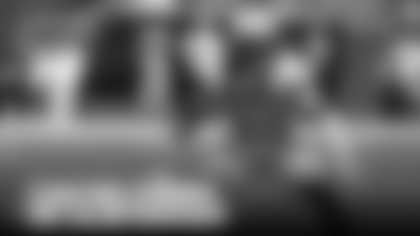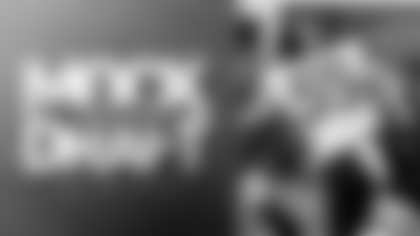Two West Coast quarterbacks will tempt teams in need of a franchise passer to spend an early pick on the position in this year's NFL draft. Cal's Aaron Rodgers and Utah's Alex Smith could, in fact, become the first two players selected.
San Francisco and Miami have the first two picks of the draft and those destinations would accommodate Rodgers and Smith's talents, which would seem to favor warm weather or domes. "They are not northeast quarterbacks," said Tony Pauline, publisher of TFY Draft Preview. For the second consecutive year, Pauline will assist jaguars.com in grading the NFL draft crop.
Rodgers, 6-2, 220, played for coach Jeff Tedford, who also produced Akili Smith and Joey Harrington at Oregon and Trent Dilfer at Fresno State. Is that a commendation or condemnation?
This much we know about Rodgers: He's the only quarterback to have beaten USC in the last two years, and he almost did it twice.
Rodgers is very accurate and has great timing in the short passing game. He's done a great job of commanding an offense that didn't surround him with great talent. Rodgers is a top competitor who has great intangibles. He's not real big and his deep-arm accuracy is marginal, which means he's not a typical, cold-weather pocket passer. Rodgers is more of a "West Coast offense" rhythm quarterback. He might be perfect for the 49ers, who invented the position.
Smith has size, 6-4, 212, but it's difficult to know what his upside is because Smith played against inferior competition in college and Utah almost never threw the ball downfield. Smith is a student of the game who beat up on lesser competition. He has been branded a "system quarterback" and there are more questions about him than there are about Rodgers. Miami has the second pick and is in desperate need of a quarterback around whom Nick Saban can re-build the Dolphins. Is Smith that quarterback? He has definite home run/strikeout potential.
Auburn's Jason Campbell, 6-5, 228, had a great senior year. He's a top athlete with great size and good arm strength. He finished on an upswing with a strong performance at the Senior Bowl. Is Campbell beginning to realize his potential or is he a one-year wonder? His arm can be a little wild at times. He is far from the finished product but his skills make him an early-second round candidate.
Akron's Charlie Frye, 6-3, 210, has a full understanding of the game, makes good choices and was productive with inferior personnel around him. Frye has a lot of upside but needs work. He had a lot of coordinators at Akron and, as a result, his development was hampered. He can be a streaky passer and he did not work-out well at the scouting combine. Frye figures to go late in the second round or early in the third.
Andrew Walter, 6-6, 234, has the best size, but he also has a very low release point and a lot of his passes are batted down at the line of scrimmage. Walter is not mobile and must have a good offensive line in front of him. The Arizona State senior separated his shoulder in November and did not play in the Senior Bowl or work-out at the combine. He is expected to work-out for scouts in a personal pro day just before the draft. His stock will rely entirely on that workout. With a top workout, Walter is the pocket-passer prototype.
That brings us to Pauline's "Blue Plate Special," Adrian McPherson of the Indiana Firebirds. McPherson was suspended by Florida State two years ago and was recruited to play in the Arena League by former NFL quarterback Steve DeBerg. McPherson played two years for DeBerg and threw for 61 touchdowns and over 3,000 yards in the 2004 season. Several NFL teams wanted to sign McPherson as a free agent, but the NFL ruled he must make himself eligible for the draft.
"He was the best quarterback at the combine, bar none," Pauline said. "Physically, he's the most talented quarterback in the draft. When you put the whole package together, he ranks as the top quarterback in this draft."
The problem, of course, is that McPherson hasn't been on a regulation field in over two years. He could go as high as the second round, but that would also represent a major risk for a guy who has only done it on an inferior level.
Purdue's Kyle Orton was a productive quarterback at the highest level, but there are major talent concerns. At 6-4, 220, Orton has the size and he is known for making good decisions, but he has an average arm and average mechanics and doesn't project well at the NFL level. He appears to be destined for an early pick on the second day.
The same can be said of Georgia's David Greene, 6-3, 227, who lacks the arm strength for the pro game.
UConn's Dan Orlovsky, 6-5, 236, is a big, strong-armed, physically-impressive prospect. He needs work on his mechanics and decision-making.
Oregon State's Derek Anderson never got back to the performance of his sophomore season. Anderson, 6-6, 240, has as good an arm as any quarterback in the draft, but he doesn't make good decisions. He's a great physical specimen but has yet to master the mental part of the position.
Miami's Brock Berlin, Oklahoma's Jason White and Louisville's Stefan LeFors are recognizable names that carry draftable grades. Cincinnati's Gino Guidugli's draft stock fell during a poor senior season.
Two other quarterbacks, Rasheed Marshall of West Virginia and Matt Jones of Arkansas, will fit prominently among the crop of wide receivers.














